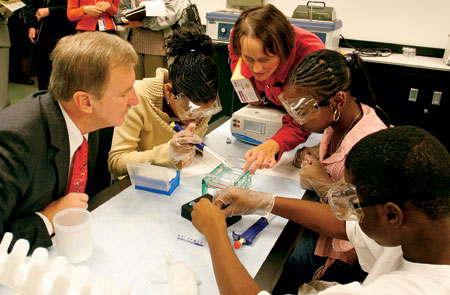Back

Museum Director Bill DeWalt joins biology teacher Ellen Wright
and her students in the new Fisher Scientific Biotechnology
Laboratory.
A few years ago, who would have guessed a bunch of forensic
scientists would be the sex symbols of prime time TV? Now
it’s hard to imagine television without the CSI:
Crime Scene Investigation series—all four or
five of them—and all its intoxicatingly grizzly story
lines.
But Lauren Giarratani, a University of Pittsburgh
research specialist, isn’t at all surprised. “It
looks cool,” she says, simply, of the appeal of forensic
science. “And people love to solve mysteries.”
Kids,
especially. And it’s mystery-loving kids that
Carnegie Museum of Natural History and Fisher Scientific
want to attract to the museum’s new Fisher Scientific
Biotechnology Laboratory. The lab’s inaugural, biotech
science investigation took place on October 15, when middle-school
students from
Perry Traditional Academy and their biology teacher, Ellen
Wright, performed some genetic fingerprinting thanks to
sophisticated lab equipment donated by Fisher Scientific.
They extracted DNA from a number
of organisms and then identified their origins.
“
Biotechnology is a 21st-century science,” Wright
says. “We hope that by having students conduct fun
and engaging biotechnology experiments, we can capture
their interest and encourage them to study and pursue careers
in science.”
Wright, a finalist for the 2005 National
Biotechnology Teacher of the Year Award, developed the
curriculum that
other visiting school groups and their teachers will use
to conduct experiments in the Fisher Lab. The museum will
also hold teacher training, starting in December, to help
biology teachers become proficient
in biotech science so they can share that knowledge with
their students. Funding for all of the curriculum development
came from The Grable Foundation.
The lab will be open on
Saturdays, too, so that families can do some scientific
sleuthing together. Those programs are being developed
by Lauren Giarratani, who was a biotech researcher before
joining the University
of Pittsburgh’s Center for Learning in Out-of-School
Environments (UPCLOSE).
“
Our goal is to engage the public with real science and
help them make a connection between what they see at the
museum—the biodiversity shown in all of the exhibits—and
biotechnology,” Giarratani explains.
Nancy Drew, Eat Your Heart Out
Giarratani compares the public’s current fascination
with forensic science to the thrill of reading a good mystery
novel. As kids, she says, “we read Nancy Drew and
The Hardy Boys and imagined
ourselves doing what they did”—solving mysteries
and catching criminals.
At Carnegie Museum of Natural History,
kids don’t
have to imagine. They can take part in mystery-solving
overnighters and summer camps with names like Forensic
Fanatics, Super Sleuths, Carnegie Science Investigation—and,
for the holidays, Who ate the Cookie? And the
adventure seekers will now be conducting their investigations
with the aid of current DNA-identification technology in
the Fisher Lab.
A description of the CSI overnighter reads like this:
Join the Carnegie Science Investigation team as an
overnight detective and help us find out who
took the carved walrus tusk! Our young detectives help
crack the case by collecting evidence at the scene, dusting
for fingerprints, extracting DNA, doing a hair and fiber
analysis, and utilizing other sleuthing skills.
Douglas
Chew, Ph.D., a medical researcher at the University of
Pittsburgh, volunteers on the scientific overnight adventures.
Working with the museum’s Trish Radford, he helps
come up with new experiences for kids who come to camp
out at the museum and experience something totally unique.
“
I really like to share the science I love,” Chew
says. “And now that we have this great laboratory
from Fisher Scientific, we can really do Class A science.”
Fisher
Scientific was founded in Pittsburgh in 1902, and today
the company supplies more than half a million products
and services to university scientists, hospital researchers
and physicians, scientists working in pharmaceutical companies,
and government researchers.
In addition to the new Fisher
Scientific Biotechnology Laboratory, located in one of
the museum’s basement
classrooms, the company recently donated equipment to outfit
the museum with a new molecular lab, which also bears the
Fisher name. The lab is being used by museum scientists,
researchers, and students from regional universities, and
as a training center for Fisher Scientific staff. Fisher
plans to update both labs as needed.
“
Our goal in partnering with the museum is to help educate
young people and foster scientific discovery in the Pittsburgh
region,” says Ed Pesicka, general manager for Fisher
Scientific Research.
From the looks of determination on
the faces of Ellen Wright’s
eighth-grade biology students as they participated in the
Biotech Lab’s first classroom experiment, the Carnegie
Museum-Fisher Scientific partnership is sure to produce
at least a few biotech scientists. And lots of engaged
mystery lovers.
Back
| Top |